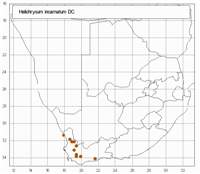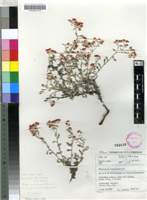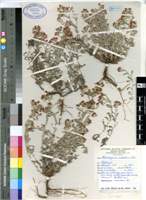Origin of name:
incarnates = flesh-coloured
Diagnostic characters:
Bracts rosy pink, lanceolate. opaqueLarge solitary flower heads
Description:
Bushy half-shrub c. 100-200 mm high, branching from the base and woody there, branches often simple or subsimple, branching only above into the compound inflorescence, thinly greyish-white woolly, leafy, leaves often with dwarf axillary shoots, these sometimes terminating in a solitary head. Leaves mostly 12-20 x 3-5 mm, diminishing in size upwards, subspathulate, uppermost lanceolate or oblong, apex obtuse to subacute, mucronate, base broad, half-clasping, sometimes auriculate, margins often slightly crisped, both surfaces greyish-white woolly. Heads c. 5 x 4 mm, turbinate-campanulate, 2 or 3 together at the tips of the branchlets, these arranged in a large leafy corymbose panicle. Involucral bracts in c. 6 series, graded, imbricate, all lanceolate, acute, outer somewhat woolly on the backs below, tips membranous, light golden-brown sometimes suffused pink, acute, not squarrose, becoming opaque inwards, pink to light scarlet, innermost sometimes whitish, overtopping flowers, radiating. Receptacle scarcely honeycombed. Flowers 27-48, 4-8 female, 21-44 homogamous. Achenes not seen, ovaries with myxogenic duplex hairs. Pappus bristles many, equaling corolla, scabrid, bases not cohering.
Flowering between September and November.
Distribution:
Endemic to the SW. Cape, rarely collected, and recorded only from sandy flats in Worcester, Bredasdorp and Riversdale degree squares.
Fynbos and Succulent Karoo Biomes.
Notes:
H. incarnatum is allied to H. cylindriflorum but is distinguished by subtle differences in the involucre. The bracts are decidedly lanceolate, not mostly oblong as they are in H. cylindriflorum, and although there is some wool on the backs of the shafts, it is not so conspicuous as it is in H. cylindriflorum and does not web the bracts together. Many of the bracts have a rosy cast (rare in H. cylindriflorum) though the tips of the inner bracts may be creamy white: these tips are more acute than they generally are in H. cylindriflorum, longer (the longest c. 2-2.5 mm), flatter, and always opaque, and the outer bracts are not squarrose. There appear to be generally more flowers in the head too, though counts are too few to be certain.
Taxonomy:
Literature:
Helichrysum incarnatum DC., Prodr. 6: 191 (1838).
Type:
Type: Cape, Breede River, Dr�ge 5775 (G-DC, holo.; K; fragment S, iso.).
Synonym(s):
Gnaphalium incarnatum (DC.) Sch. Bip. in Bot. Ztg 3: 171 (1845).
Helichrysum rubellum (Thunb.) Less, var. incarnatum (DC.) Harv. in F.C. 3: 220 (1865).
H. ramulosum DC., Prodr. 6: 176 (1838). Gnaphalium ramulosum (DC.) Sch. Bip. in Bot. Ztg 3: 169 (1845). Type: Cape, Hassaqua's Kloof, 28 i 1815, Burchell 7530 (G-DC, holo.; K, fragment BOL, iso.).
Vouchers:
Acocks 1670 (S); Barker 7510 (NBG); Hilliard & Burtt 13059 (E; K; MO; NU; S); Muir 674 (PRE).




